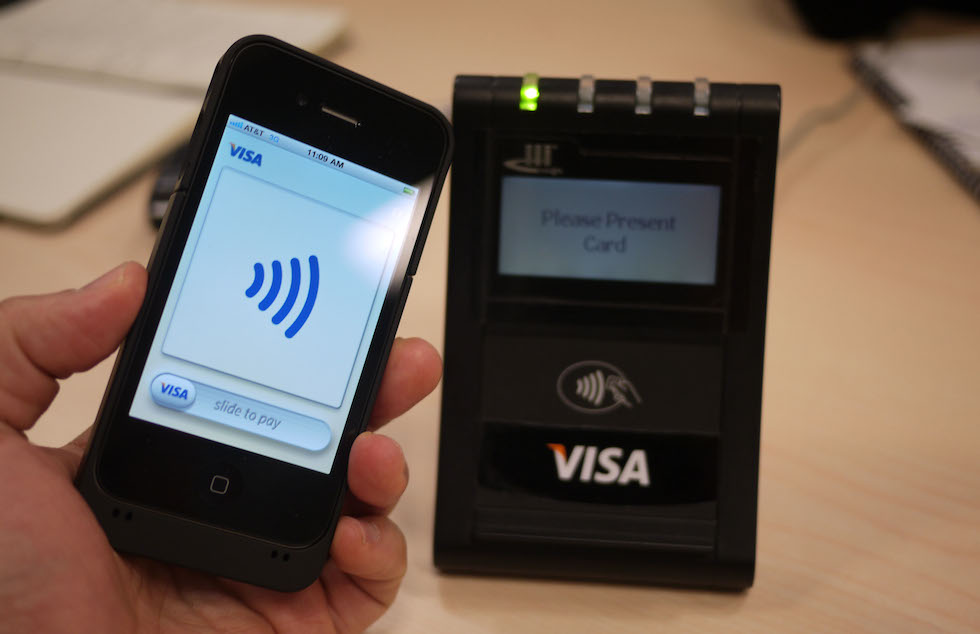
Visa today announced a consolidation of its disparate payments solutions into Visa Digital Solutions, a suite of products, services and developer tools aimed at bringing payments to smartphones and wearables.
Last week, the company launched Checkout, a multi-screen solution for online payments. But omitted from that announcement was an explanation of how Visa plans to tackle the next generation of physical payments, which is made more complicated by the tenuous relationship between merchants, acquirers, financial institutions, government bodies and Visa itself.
As detailed in a release today, Visa Digital Solution tackles the problem of future payments into categories: support for new payment methods; and next-generation consumer protection measures.
The former ties into what is already on the market, and what is likely to come in the near future: wave-to-pay. Canadians can currently use select NFC-capable devices along with special SIM cards with so-called “secure elements” to make payments at merchants with compatible touchless points of sale, but these are limited to Android, BlackBerry and Windows Phones — devices with Near Field Communication antennas.
While only NFC-based solutions for wave-to-pay, or what Visa called payWave, are available at the moment, Apple has been rumoured to be working payment networks like Visa, MasterCard and AMEX to add a secure element to its upcoming iPhone. Coupled with updated points of sale, or additional hardware, these devices will have the capabilities for tap/wave-to-pay as the latest Android or BlackBerry devices.
The next type of payment is QR-code based, called scan-to-pay. Visa recently published a specification for securely displaying customer payment information as a QR code, and should allow Starbucks-like scanning for credit or debit payments. Of course, the information displayed would not directly translate to a user’s payment credentials, and that’s where the next-generation consumer protection measures come in.
Likely the most important change to how payments will be processed in the future is how they will be stored. Tokenization, the ability to replace a customer’s 16-digit credit card number with an equivalent set of random numbers that represent the real thing, allows third-party vendors to safely handle transaction information without the same security concerns. Because tokens represent, and replace, the actual payment information credentials, they can be safely stored on a smartphone or wearable, or on a company’s cloud. If a device is stolen, or a server breached, not only is there limited concern that the token can be decrypted, but in such an event it can be remotely disabled and a new one issued. This avoids a small breach necessitating a physical card replacement.
Indeed, tokenization is so important that Visa is working with all of its merchants, acquirers (point-of-sale providers) and issuers to make them quickly an industry standard.
While this ties into the likely NFC-deficient iPhone 6 in many ways, tokenization also points to another technology that Visa has been working on over the past year: Host Card Emulation A secure element is great because it ensures that payment credentials are securely stored in something physical, but it also necessitates the purchase of something physical, too — in this case, a SIM card. Host Card Emulation, or HCE, recreates a smart card, in this case a Visa card, in software. While HCE is only available on Android 4.4 devices and above, it will, along with the implementation of tokenization, allow for a greater number of devices — and wearables — to facilitate payments.
According to The Information, Apple has been speaking with Visa and other payment providers on bringing a wallet feature to the iPhone 6. According to Amir Efrati, “Apple has told some partners its system would involve a so-called secured element in the phones—a piece of hardware where sensitive information such as a phone owner’s financial credentials can be stored. The company also aims to run the system without giving up any control to wireless carriers.” Whether this would come in the form of a dedicated app, or an expansion of Passbook, remains to be seen, but Apple products have heretofore been left out of the NFC-based mobile payment game, something of which Tim Cook and co. are keenly aware.
As for Visa Digital Solutions, the effort will roll out early next year in the US, followed by a Canadian launch shortly thereafter. Expect Visa Checkout to be far more ubiquitous long before then.
[source]Visa[/source]
MobileSyrup may earn a commission from purchases made via our links, which helps fund the journalism we provide free on our website. These links do not influence our editorial content. Support us here.


